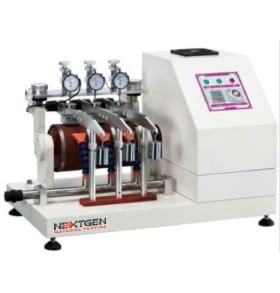
There is no doubt that rubber is one of the more resilient materials used in manufacturing right now. However, just as with any material, rubber is not impervious to damage from constant wear and tear.
Thus, it becomes necessary to determine the strength of rubber before it is applied for any purpose. This is where investing on an NBS Abrasion Tester becomes an important decision. But, before deciding on purchasing one, it would be better if you could understand the process first.
What Is the NBS Abrasion Test?
Like other rubber abrasion tests, the NBS procedure follows the same concept of placing a test material on the surface of a rotating drum covered with abrasive material and then gauging its strength by how much volume it retains. However, what’s unique about the NBS procedure is that it was specifically designed to test materials with a thickness of at least 2.5 millimeters or 0.1 inches.
This means that the test is ideal for vulcanized rubber, as well as those used in footwear. The rationale behind this procedure is that thick rubber is expected to withstand a lot of stress and friction when in use. Essentially, rubber of this grade is much thicker and denser than standard polyurethane rubber. This allows them to retain more volume under friction.
Thus, the resistance to rubber abrasion for these materials cannot be properly gauged if the test parameters used in procedures like the DIN method were to be applied. Instead, a more abrasive sheet would be used to test the material’s strength. This way, it is exposed to longer and more intense revolutions.
The Test Procedure
The NBS Abrasion Test follows roughly the same processes as other rubber abrasion tests.
A. Material Preparation
The test requires for the sample to have a 1 inch by 1 inch size and a thickness of 0.25 inches at most. If the material is too thin, it can be plied up with equally thin materials of the same composition. This would still allow for accurate test results.
If the sample is to be derived from a finished product, the surface has to be buffed and cleaned to meet test specifications. Also, every non-essential materials for the test like fabric and any treatment on the surface like adhesives must be removed.
B. Machine Calibration
The NBS Abrasion Tester must be cleaned of any debris left from previous tests. This is to prevent foreign objects from entering into the machinery that would affect the tester’s functions. The arms holding the test sample should be checked to determine if they can secure the sample while the drum is revolving.
The abrasive sheet would then be mounted to the drum through adhesives. However, unused sheets might be more abrasive than used ones. As a precaution, the operator must mount a metal test piece and let it run through the sheet for 500 revolutions. This should soften the surface of the sheet, enough to make the test accurate.
C. Test Proper
Once the materials are prepared, the operator will then mount the sample on the NBS Abrasion Tester, and set the rotation speed and number of revolutions. What the operator must then do at that point is to make sure that the sample always makes contact with the abrasive sheet as the drum spins.
There are instances when the sample might break or chatter on the test block. This would lead to an unreliable result. This is why the operator must have prepared at least 5 other similar samples. They should also conduct the test at least 5 times for each sample to ensure that the results are accurate and compelling.
Reliably Using the NBS Abrasion Tester
The NBS Abrasion test should make for a rather reliable procedure to test the quality of hard rubber. It is worth considering the following:
1. Unreliability with Other Rubber Classes
Due to the higher set of parameters used in the machine, the NBS abrasion test is only ideal to gauge vulcanized rubber abrasion resistance. It is a rather unreliable test procedure when materials that differ greatly from the reference compound is used.
For instance, the NBS tester can easily grind through thin polyurethane materials within a few short revolutions. In essence, any material that is thinner or weaker than vulcanized rubber will sustain massive volume loss under the test, resulting in failure.
2. High Tendency for Chattering
Since the test material is being applied to the drum through downward force, there is a chance that the sample will bounce frequently through the test. This is what is called chattering, and it indicates that the material is not “sliding” through the surface. Instead it consistently skips several inches off the abrasive sheet.
A single instance of chattering might still yield some usable data. However, multiple instances of chattering occurring for the same sample type should be treated as a failure.
3. Extensive Material Preparation Time
Prior to using the NBS Abrasion Tester, the operator must make sure that the test material fits the specifications of the procedure. If the material is derived from a finished product, this will include cutting the sample, and removing any treatment applied to it like protective film and adhesives.
The operator must even check for imperfections in the sample’s test surface like voids or pores as these would lead to inaccuracies in the test. In essence, it would take at least half a day for a sample material to be ready for testing.